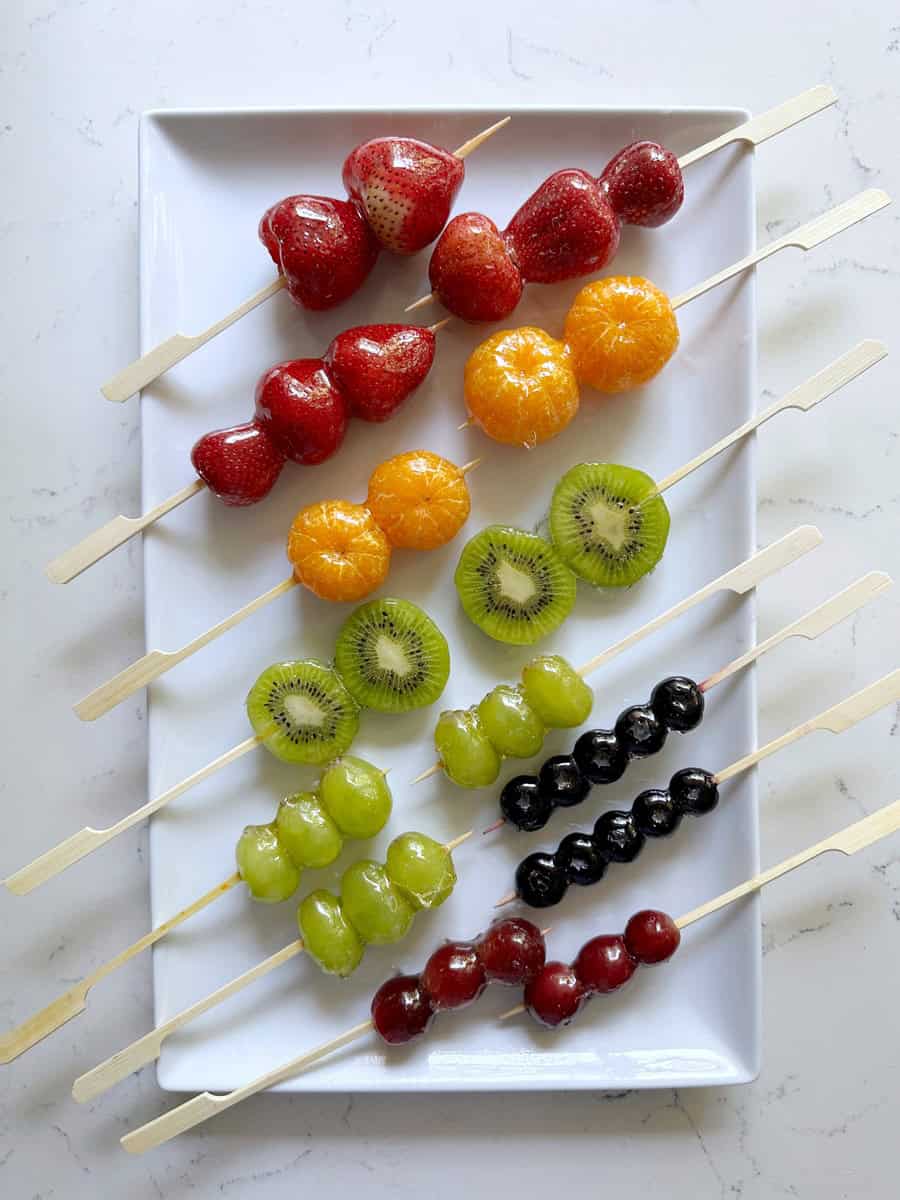
CA GROWN Blog
Discover. Learn. Connect.
How to Make Tanghulu, Candied Fruit Skewers
Meet Them Here
Read Bios »How to Make Tanghulu, Candied Fruit Skewers
If you spend any time at all on social media, you’ve no doubt seen people clacking together skewers of fruit that are covered in what looks like glass… it’s tanghulu! And the fruit isn’t covered in glass, it’s covered in a thin layer of sugar coating that’s shatteringly crisp and makes fresh fruit fun to eat. Sarah Gim shares how to make it below.
What is Tanghulu?
Tanghulu, sometimes called “bing tanghulu,” is a candied fruit snack originally made by skewering red hawthorn berries, dipping in sugar syrup, and letting the shell harden. Tanghulu is now made with all kinds of fruits like strawberries, mandarin oranges, grapes, and even cherry tomatoes. Though it’s having a moment around the world right now, tanghulu goes back hundreds of years to northern China.
What You Need for Tanghulu – Ingredients
- Sugar, 2 cups
- Strawberries and other fruit, about 2 pounds
You will also need water to make the sugar syrup.
What You Need for Tanghulu – Tools and Equipment
- skewers
- heavy-bottom stainless steel pot with a sturdy handle that you can tilt on the stovetop
Not required but nice to have:
- silicone brush to wipe down sides of pot if needed
- parchment paper
- candy thermometer- this is not required, but if you don’t have a lot of experience in the kitchen, it will help you determine when the sugar coating is ready
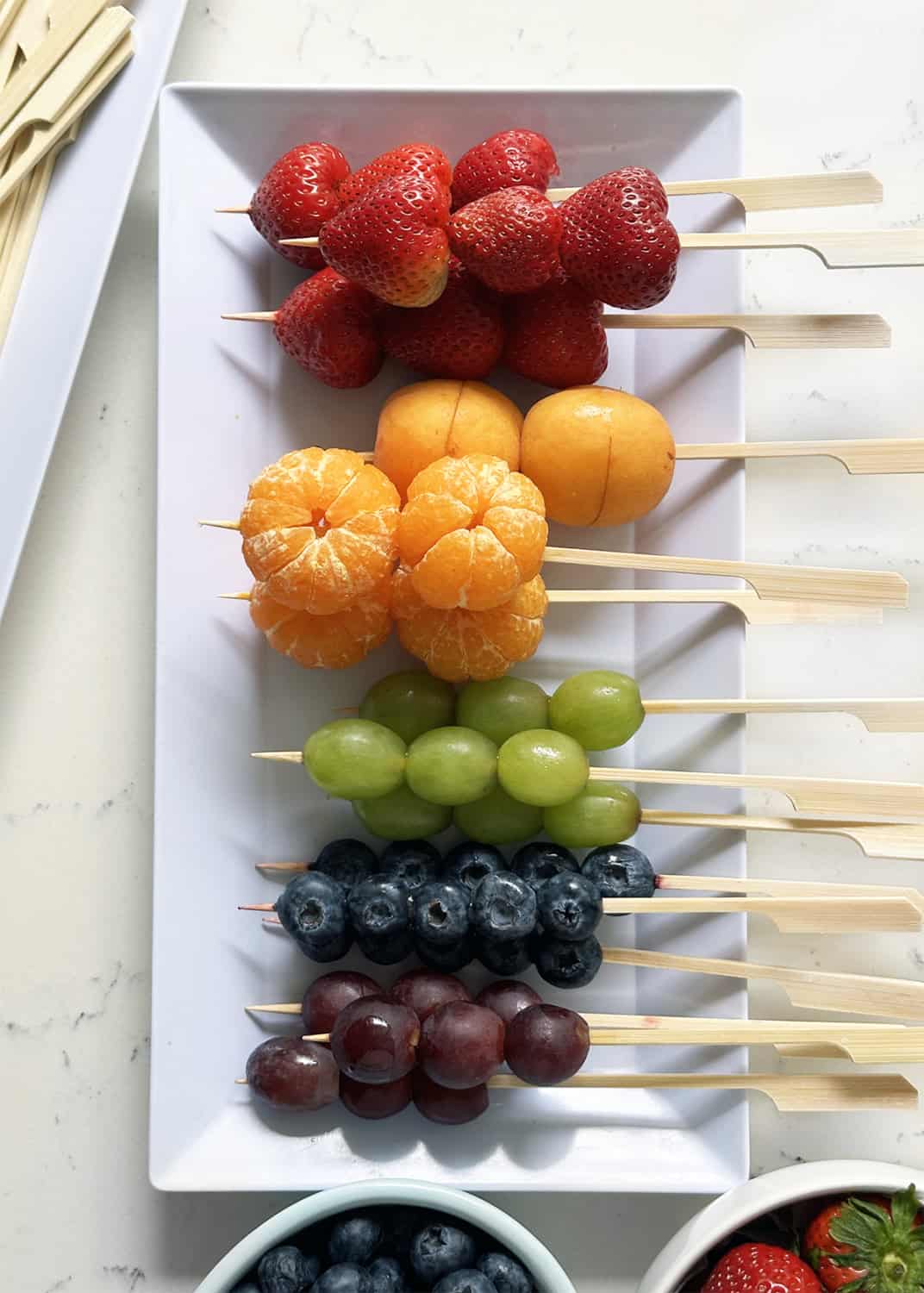
What Fruit Should I Use for Tanghulu?
Original tanghulu used hawthorn berries, which are small, round tart tree fruit that has the shape and texture of small apples. What makes hawthorn berries ideal for tanghulu is what we use as a guide when looking at the fruit that’s available to us.
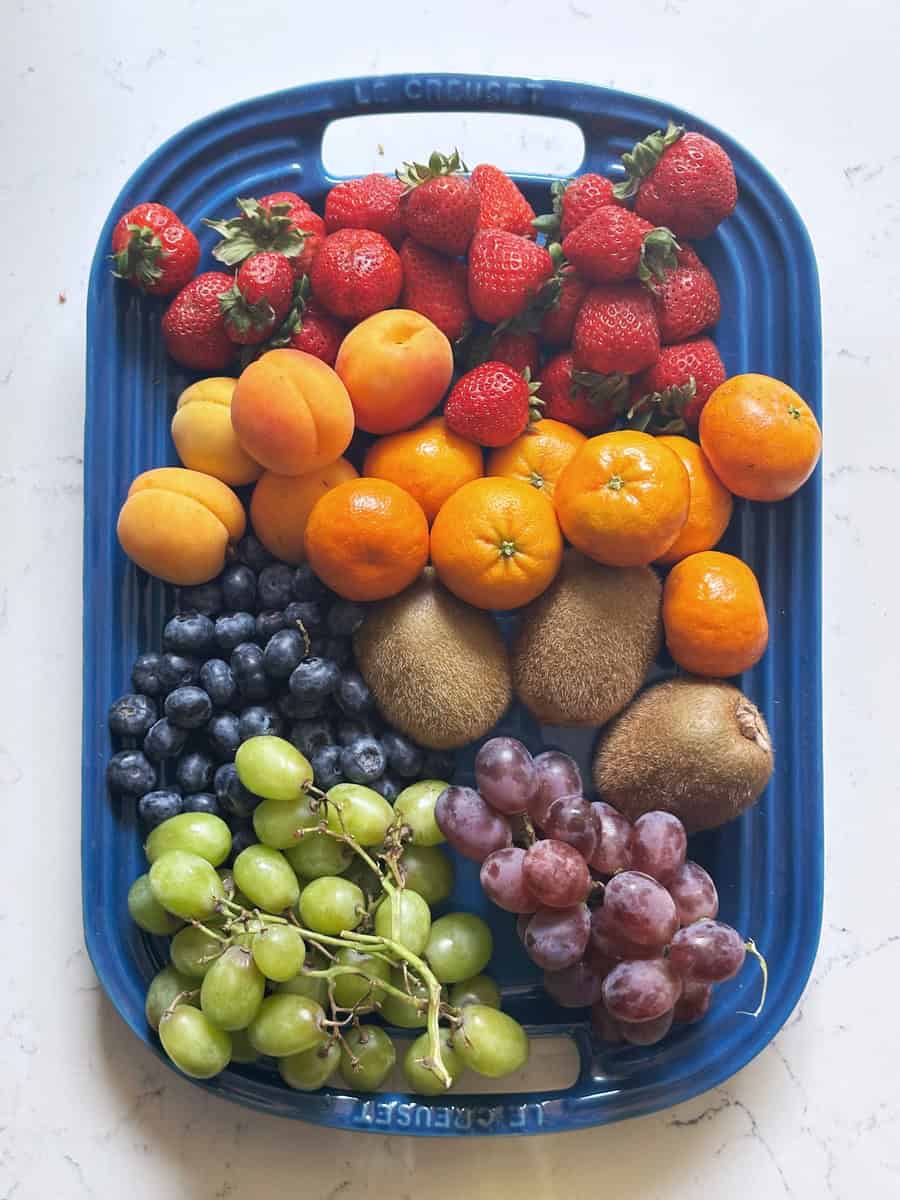
The best fruit for tanghulu has a few characteristics: small, firm/sturdy, and tart. Because the glass candy shell is sweet, the best fruit for tanghulu is sweet-tart or even straight up sour. This helps balance sweetness. Firm or slightly underripe fruit rather than soft fruit is better. Fruit that retains the peel also works better than fruit you have to peel because the sugar syrup will adhere better.
The best fruit for tanghulu has a few characteristics: small, firm/sturdy, and tart. Because the glass candy shell is sweet, the best fruit for tanghulu is sweet-tart or even straight up sour. This helps balance sweetness. Firm or slightly underripe fruit rather than soft fruit is better. Fruit that retains the peel also works better than fruit you have to peel because the sugar syrup will adhere better.
Here are the best fruits for tanghulu, what makes them work, when they’re best in season, and how to prep them for the recipe:
Best Fruit for Tanghulu
Strawberries. We love all the berries but strawberries work best for tanghulu because they are bigger, firmer, and tarter than blackberries and raspberries. Strawberries are also in season year-round, which means you can make tanghulu any time! To prepare, wash strawberries, dry off with clean kitchen towels or paper towels until bone dry, and either hull or leave the leafy green tops on (which are, by the way, totally edible).
Blueberries. Though I said strawberries were the best berries for tanghulu, blueberries can be great too, as long as they’re big enough to skewer. The teeny tiny wild blueberries won’t do. Blueberries are in season in California April-July.
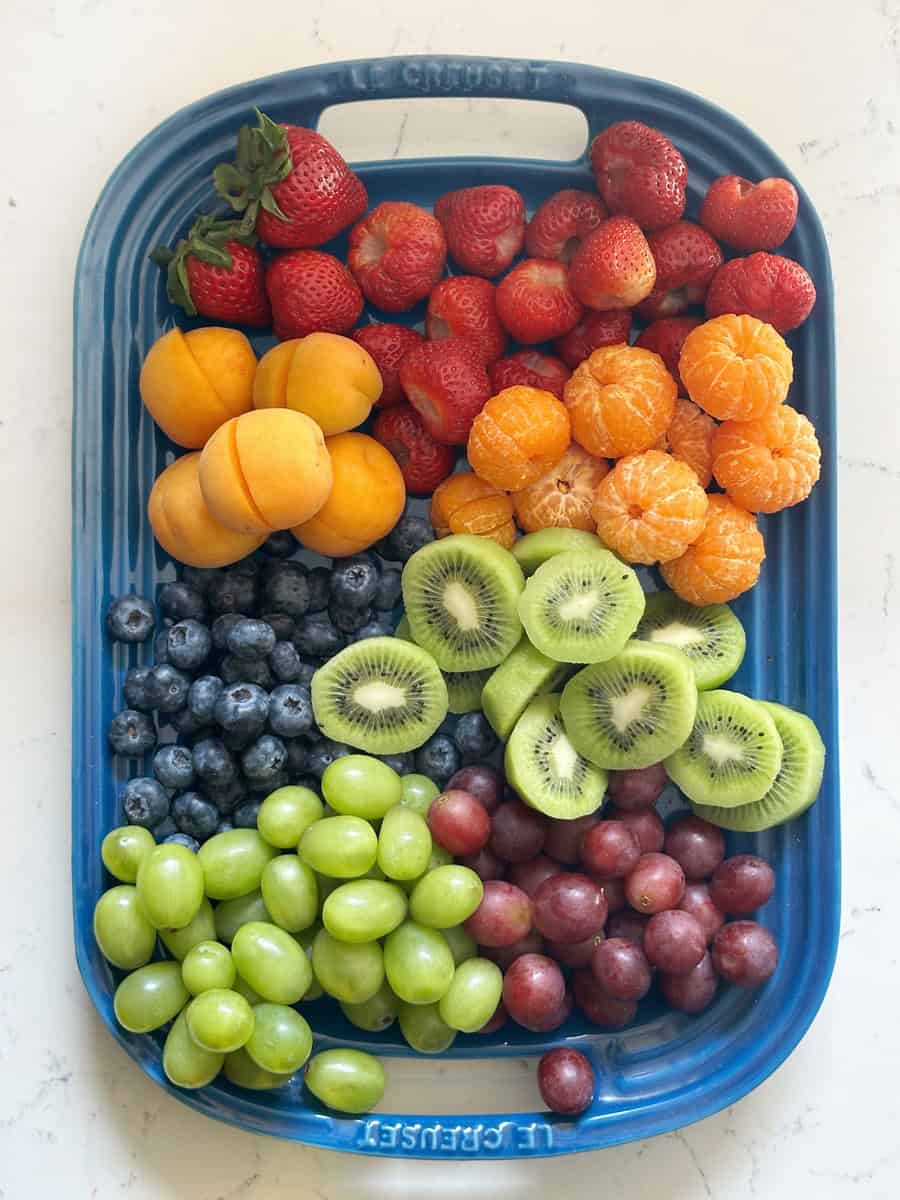
Cherries. Cherries are firm, can be tart, and are in season in California April, May and June. Pit the cherries before placing on skewers. If the cherry stems are particularly long, you can pit the cherries, leave the stem on, and use the stem instead of the skewer to dip the cherry in the sugar syrup.
Apricots. Apricots are firm and their skin holds onto the sugar syrup really well. They are in season as early as May. Slice the apricots in half, remove the pit, place the hollowed halves back together, and skewer.
Plums and pluots. Get smaller plums or pluots, about 1½- to 2-inch wide. Cut them in half, remove the pit, place the pitted halves back together and skewer like apricots. Plums are especially great for tanghulu because they are tart.
Mandarin oranges. Mandarins, like strawberries, are in season year-round in California. Buy seedless mandarins, peel them, remove any particularly thick white pith, and skewer the whole round. If the mandarin oranges are a little larger, pull apart the segments and skewer them separately.
Kiwi. Kiwi is sweet-tart, and though we generally skip fruit that you have to peel, kiwi seems to work for tanghulu. Even better, if you can find the teeny tiny kiwi berries the size of large grapes, use these since you can skewer them whole. For large kiwi, peel the skin if you’re inclined (the skin is actually totally edible) and slice. Did you know kiwi grows in California? It does! And is in season October to May.
Grapes. Grapes come in several varieties, all in season from May through the end of the year and even into January! When popping grapes fresh, I prefer the grapes with a hard crunchy texture that are super sweet. But for tanghulu, slightly sour grapes work well, which means tanghulu is great to make if you accidentally get grapes that are sourer than you were expecting.
Apples and pears. In the fall, get small apples and pears so you can skewer the fruits whole. Do not peel them or the sugar syrup will not adhere.
Cherry tomatoes. Tomatoes, as we all know, are botanically a fruit and have become a popular variation of tanghulu in Asia. If you’re into it, try it!
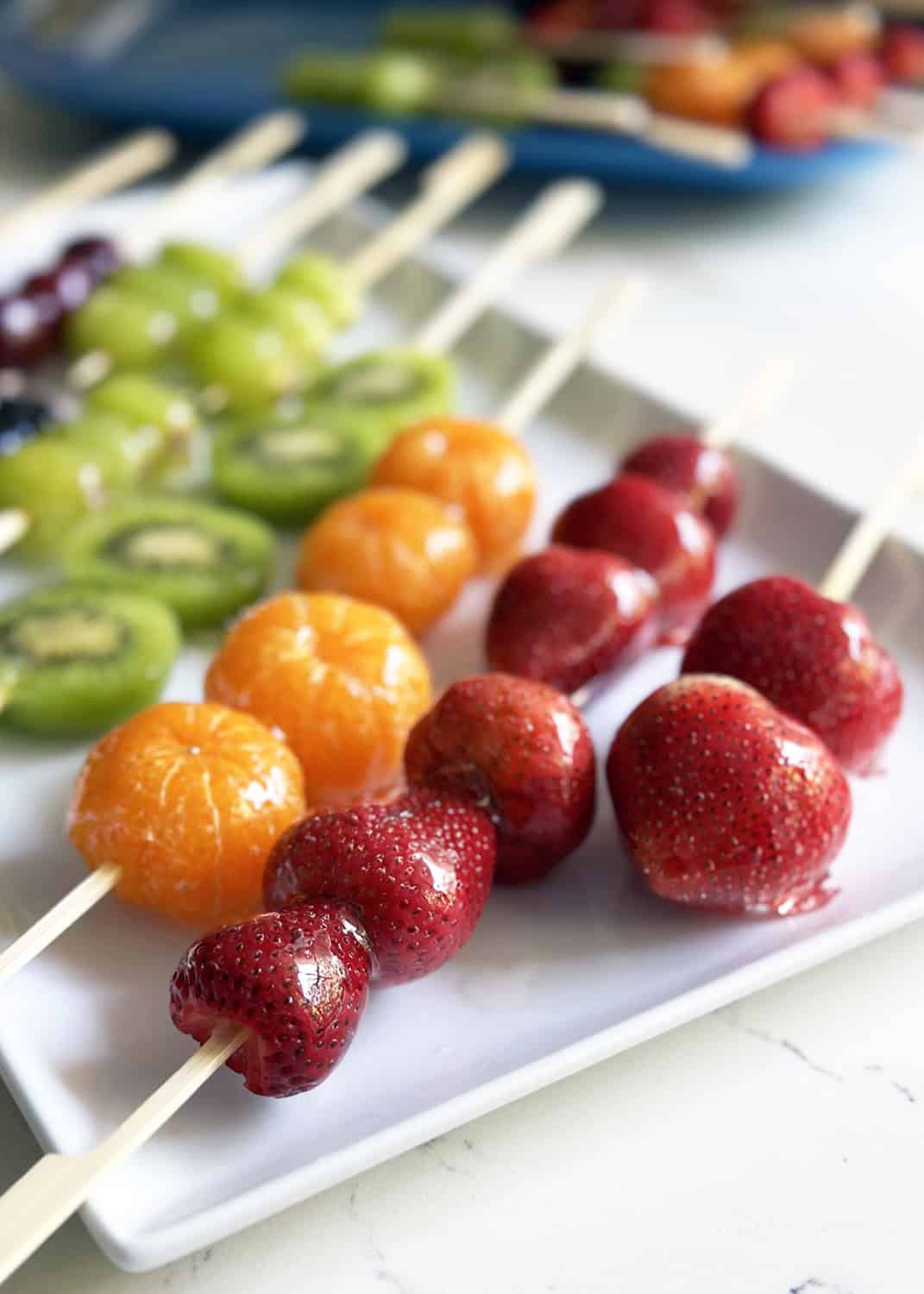
Fruit to Skip for Tanghulu
Some fruits are not ideal for tanghulu. Any fruit that is small or very soft like blackberries and raspberries, may not stay on the skewer or may break apart in the sugar syrup.
Fruits that you have to peel and cut, or that have a high water content such as cut melons, mango, and pineapple, will not work well because the sugar syrup will not adhere.
That’s not to say it’s impossible to make tanghulu with these fruits, just that it may require a little extra effort.
How to Make Tanghulu
The key to making tanghulu is to have everything—skewered fruit, ice water bath, parchment-lined tray—prepped before starting.
Prep Fruits
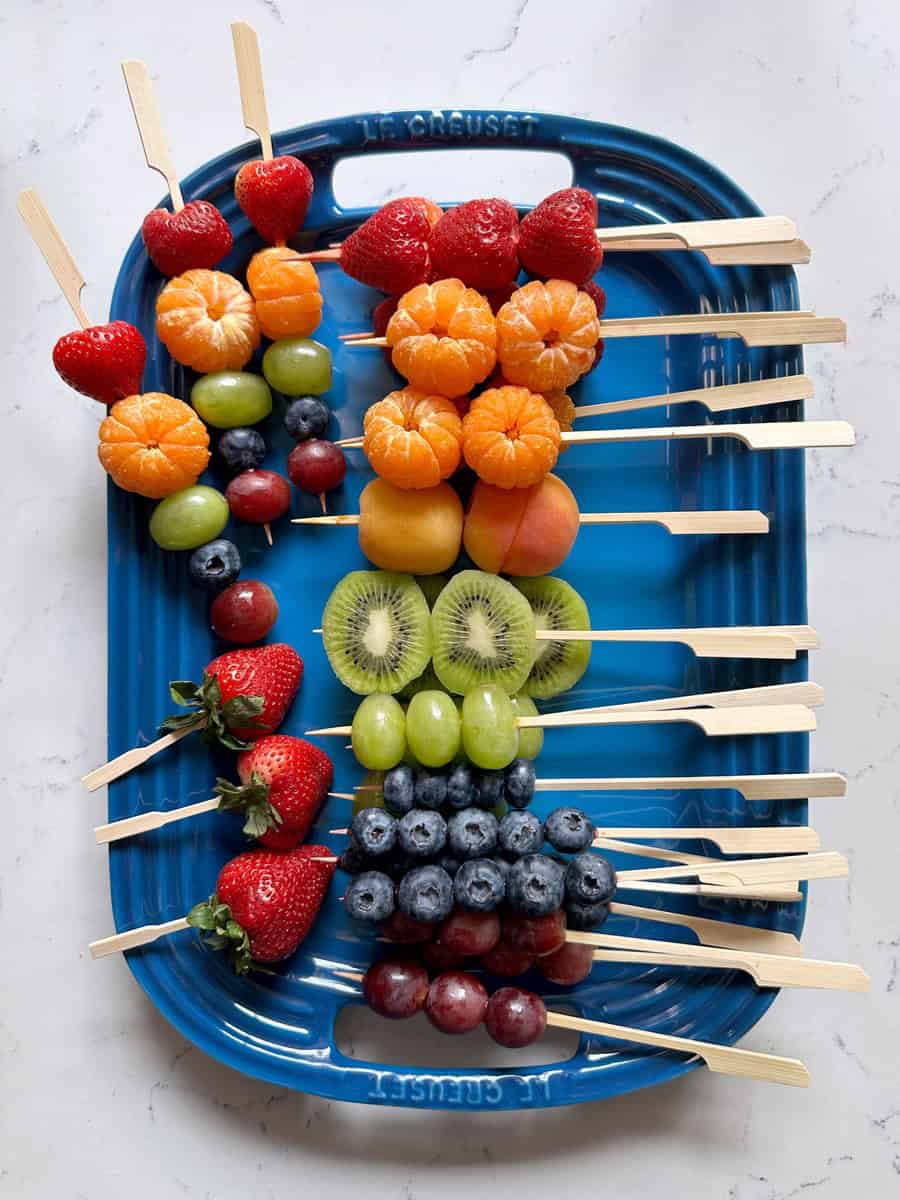
Line a large plate or tray with parchment paper.
Peel or wash, then dry fruit with clean kitchen towels or paper towels until the fruit are BONE DRY. Any water will prevent the sugar coating from adhering to the fruit.
Place 2-3 pieces of fruit—they can be the same kind of fruit on one skewer or a combination—on each skewer, not more than the height of the sides of your pot.
Fill a very large, tall glass or a bowl with half ice, half cold water.
Make Sugar Syrup
Pour sugar and water into a stainless steel pot and give it ONE gentle stir to distribute the sugar. Do not stir again after this. Turn heat to medium-high and bring sugar and water to boil. DO NOT STIR.
At 10 minutes, start checking the sugar syrup.
If you are using a candy thermometer, bring mixture to 300°F/149°C, “Hard Crack” stage.
When going by intuition, dip the end of a skewer into the sugar syrup, then into the ice water bath. If the sugar is soft or sticky, keep letting the syrup heat up to temperature. If the sugar on the skewer is hard, it’s ready for dipping!
When the sugar syrup is ready, turn off the heat.
Dip Fruit
Gently tilt the pan to move all the sugar syrup to one side. Dip one fruit skewer in the sugar syrup, spin to coat all sides of the fruit. Do not use a spoon to ladle the sugar syrup over the fruit as this will create air bubbles in the syrup and make it cloudy.
Allow excess syrup to drip off—you can also tap or spin the skewer against the edge of the pan.
Dunk the syrup coated skewer into the ice water bath, then set on parchment-lined plate or tray.
Repeat with all the fruit skewers, making sure the skewers do not touch one another.
Cool tanghulu for 10 minutes before eating to make sure the sugar is hardened and cool.
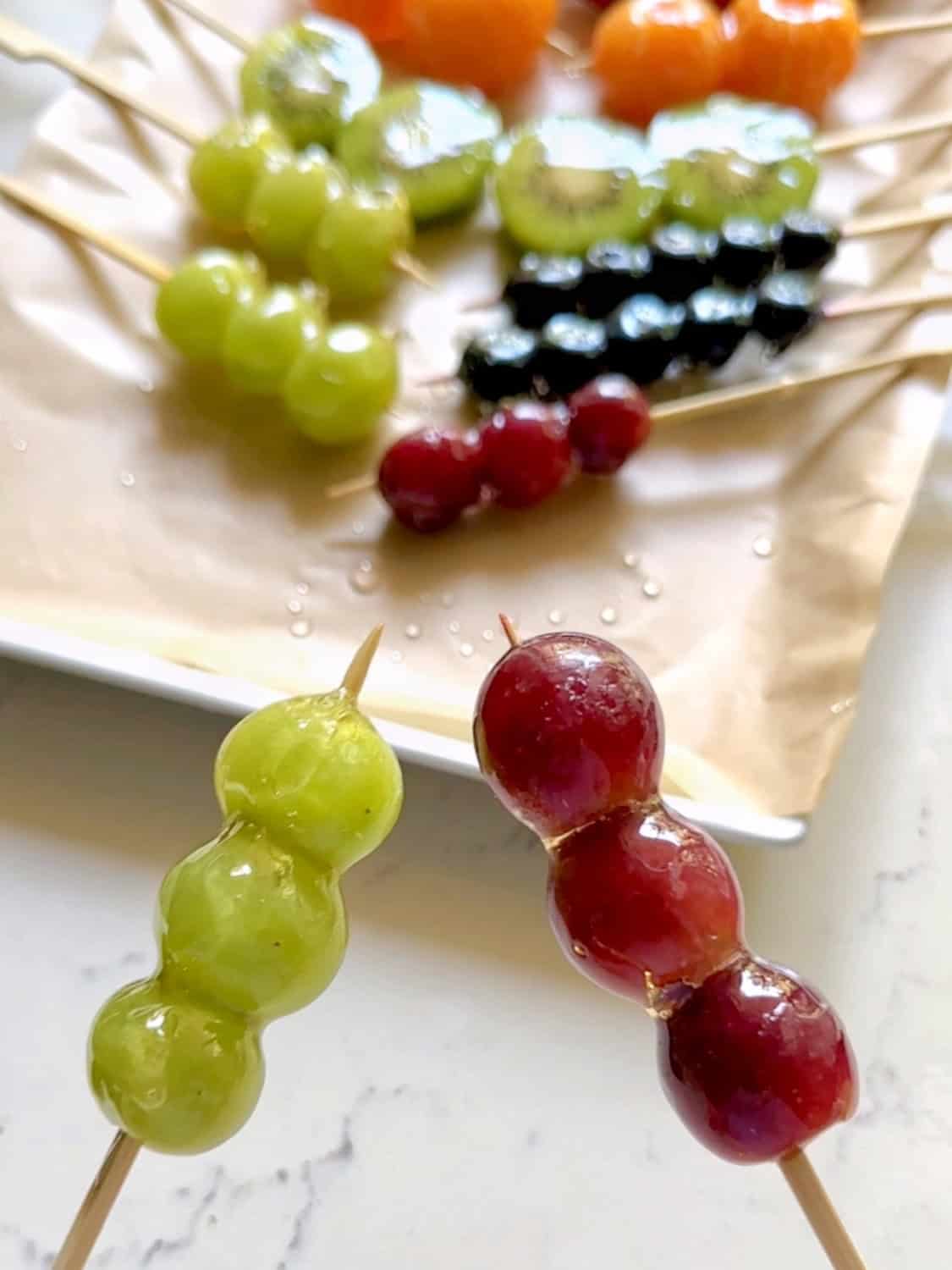
Pro-tips for Making Tanghulu
Prep fruit on skewers, ice bath and lined tray before starting. The sugar syrup heats and browns faster than you think, and the sugar coating on the fruit hardens fast. Have everything ready so you can work quickly.
Prep fruit on skewers, ice bath and lined tray before starting. This is so important that I’m telling you twice.
Best skewers for tanghulu are thin and flat like fettuccine, rather than round like a spaghetti noodle. Flat skewers prevent the fruit from spinning on the skewer, making the fruit easier to coat with sugar syrup in the pan. In a pinch, you can use disposable wooden chopsticks that have flat sides.
Place 2-3 berries or pieces of fruit per skewer, about 4- to 6-inch total or as long as the side of your pot. I know, I know, you’re tempted to skewer a bunch of fruit onto long, dramatic skewers because that’s what you’ve seen in videos, but RESIST the temptation! The professionals are boiling sugar syrup in huge cauldrons and woks that are deep or wide enough to dip those long skewers. Those of us in home kitchens have just our 8- to 12-inch stainless steel pots. Speaking of pots…
What kind of pot or pan is best to make tanghulu? Use a heavy-bottomed, regular stainless-steel pan without a non-stick coating. The heavy bottom on the pan retains heat and distributes it evenly so it will keep the sugar from burning and keep the sugar syrup at the right temperature longer after turning off the stove.
Do not stir the sugar and water mixture once it starts boiling. Stirring the syrup will create air bubbles and crystallize the sugar. Eventually, the sugar syrup will become cloudy.
Add ¼ cup of corn syrup along with the sugar and water mixture to “foolproof” your sugar syrup. The liquid corn syrup will prevent the sugar from crystallizing. Keep in mind that sugar with added corn syrup will reach the hard-crack stage faster, so you have to work even faster!
To clean out hardened sugar from your pot, add water to the pot then bring it back up to a boil to start softening and dissolving the hardened sugar. Once some of the sugar at the edges softens, the big piece of sugar should float off and you can discard it.
Sugar syrup is hotter than hot! Literally, sugar syrup at 300°F/149°C is hotter than the 212°F/100°C of boiling water. So don’t touch it with your bare hands, and definitely make sure the sugar coating is completely cooled/hardened before eating it.
Advance Prep, Leftovers, and Storage
Tanghulu is best eaten immediately after it’s made, so it’s not something you want to make too far in advance. If you live in a fairly dry climate, you can keep tanghulu on the countertop for a few hours. (Not recommended in a very humid environment.)
Beyond a few hours, wrap tanghulu in clean parchment paper and place in an air-tight container in the refrigerator.
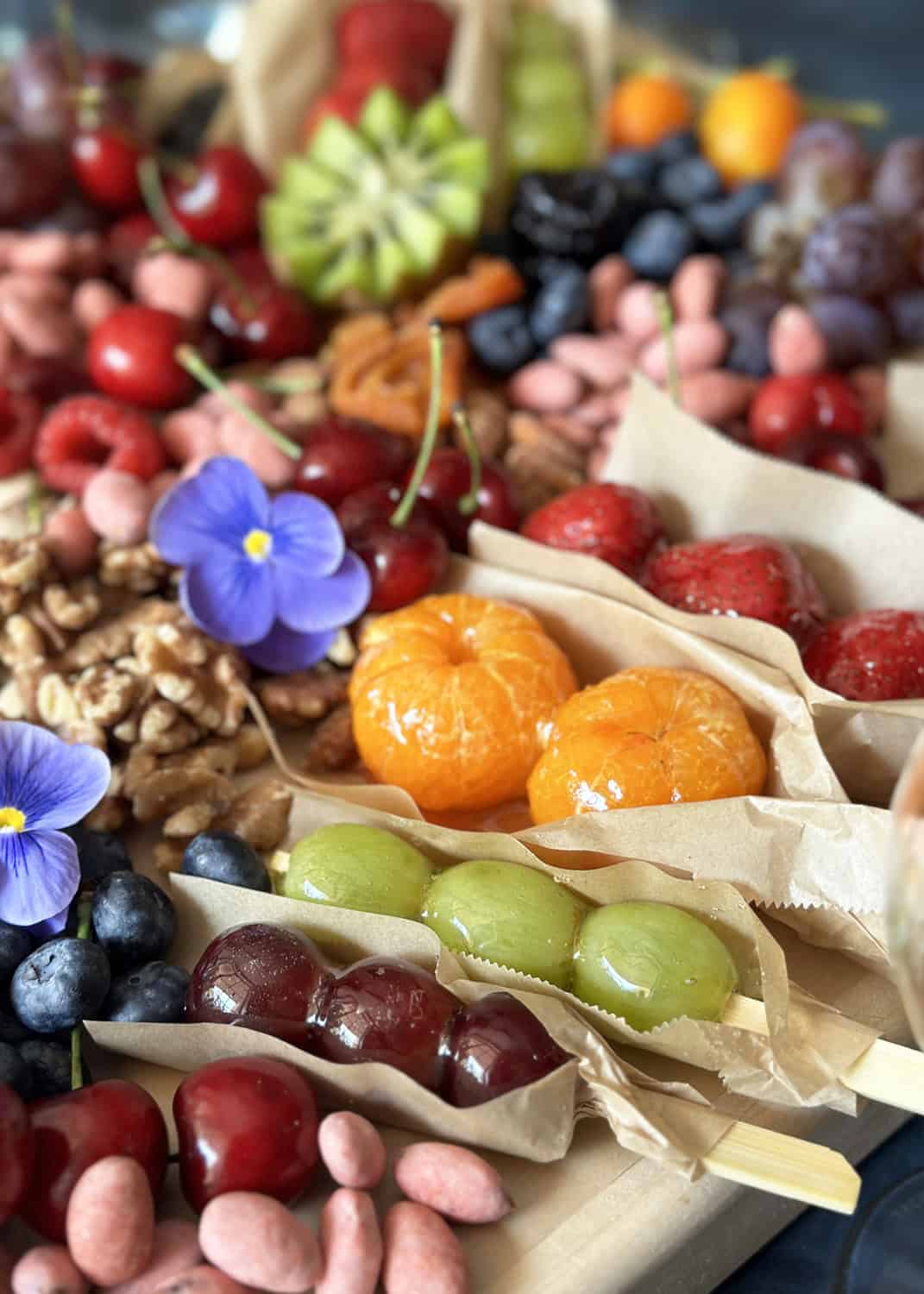
Ideas for Tanghulu
For a pretty presentation, leave the green leafy tops on the strawberries, and the long stems on any fruit like cherries. You still need to skewer the fruit to dip into the sugar syrup, but you can remove the skewers and serve the tanghulu as individual candy-coated pieces that can be picked up by their stems!
Add natural food coloring to the sugar syrup to get brighter pops of color on your tanghulu! Use beet or dragonfruit powder for red/pink, turmeric for yellow, and butterfly pea powder or spirulina for blue.
Sprinkle tanghulu right out of the sugar syrup with toasted sesame seeds, finely chopped nuts, shredded coconut or anything else! You might even try the spicy sour seasoning tajin, at the end for extra flavor.
If you are comfortable working with sugar and candy, decorate the tanghulu by wrapping with spun sugar or sugar threads for a dramatic presentation. At a certain point in your tanghulu journey, you may be able to physically spin the tanghulu skewer immediately after dipping it in the sugar syrup, but only if you’re wearing protective gear and don’t mind cleaning up hardened sugar from your walls.
Stick the finished tanghulu skewers into a whole fresh melon to serve them standing up! Or arrange them on a colorful candied fruit charcuterie board.
For you listening pleasure: Check out this California Grown Spotify playlist:
Have you tried this tanghulu candied fruit skewer recipe? We’d love to see your creations! Share your photos with us by tagging #CAGROWN on social media.
Don’t stop here! Follow us on Pinterest for more fresh and fabulous recipe inspiration. Dive into the world of CA GROWN goodness, and let’s make every meal a celebration of the Golden State’s bounty.
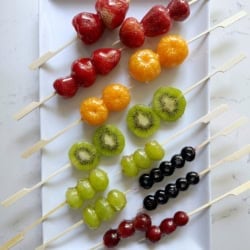
Tanghulu, Candied Fruit Skewers Recipe
Equipment
- Stainless Steel Pot
- Candy Thermometer optional
- Skewers
Ingredients
- 2 cups sugar
- 2 lbs Strawberries and other fruit
Instructions
Prep Fruits
- Line a large plate or tray with parchment paper.
- Peel or wash, then dry fruit with clean kitchen towels or paper towels until the fruit are BONE DRY. Any water will prevent the sugar coating from adhering to the fruit.
- Place 2-3 pieces of fruit—they can be the same kind of fruit on one skewer or a combination—on each skewer, not more than the height of the sides of your pot.
- Fill a very large, tall glass or a bowl with half ice, half cold water.
Make Sugar Syrup
- Pour sugar and water into a stainless steel pot and give it ONE gentle stir to distribute the sugar. Do not stir again after this. Turn heat to medium-high and bring sugar and water to boil. DO NOT STIR.
- At 10 minutes, start checking the sugar syrup. If you are using a candy thermometer, bring mixture to 300°F/149°C, “Hard Crack” stage. If you are going by intuition, dip the end of a skewer into the sugar syrup, then into the ice water bath. If the sugar is soft or sticky, keep letting the syrup heat up to temperature. If the sugar on the skewer is hard, it’s ready for dipping!
- When the sugar syrup is ready, turn off the heat.
Dip Fruit
- Gently tilt the pan to move all the sugar syrup to one side. Dip one fruit skewer in the sugar syrup, spin to coat all sides of the fruit. Do not use a spoon to ladle the sugar syrup over the fruit as this will create air bubbles in the syrup and make it cloudy.
- Allow excess syrup to drip off—you can tap or spin the skewer against the edge of the pan.
- Dunk the syrup coated skewer into the ice water bath, then set on parchment-lined plate or tray.
- Repeat with all the fruit skewers, making sure the skewers do not touch one another.
- Cool tanghulu for 10 minutes before eating to make sure the sugar is hardened and cool.
Notes
Nutrition
Get to know Sarah Gim
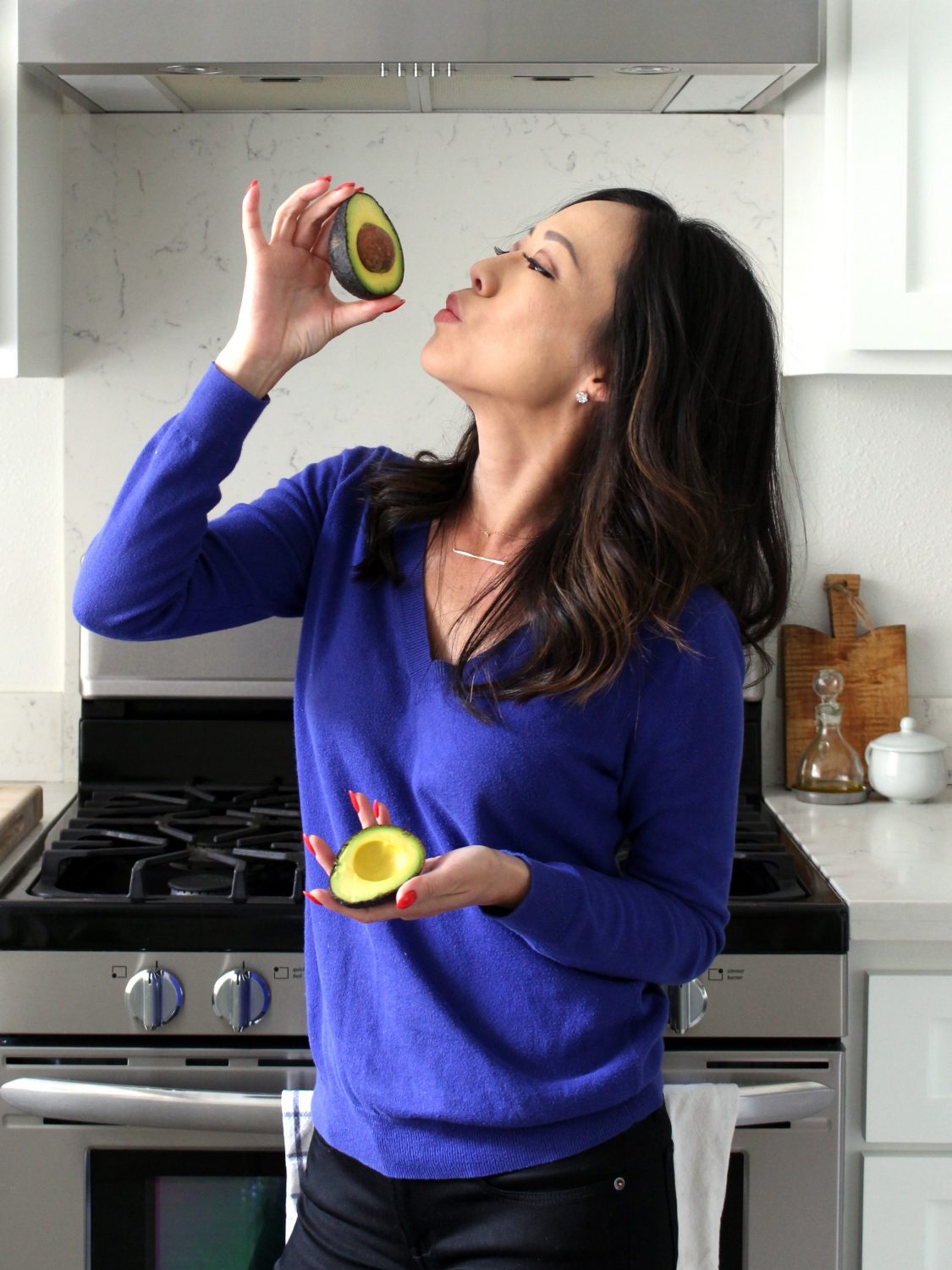
Meet Sarah, the fairy godmother of food porn. She launched her blog, The Delicious Life, as a creative outlet, quickly turning her fabulous food photos and snarky snippets into a social media sensation. Her viral “fry boards” ignited a heated internet debate: do tater tots count as fries?
In 2007, Sarah created Tastespotting, a visually stunning potluck of recipes, references, experiences, stories, articles, products, and anything else that embodies exquisite taste. The site features only the most drool-worthy food images on the web.
Sarah adores all California crops (and the wine!), but avocados hold a special place in her heart.

who knew these are so easy to make at home?!